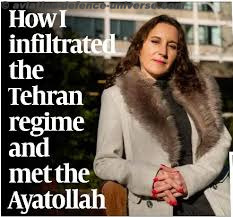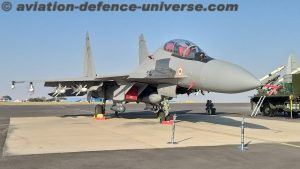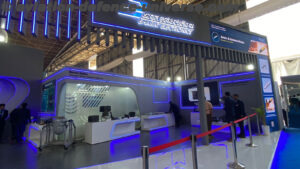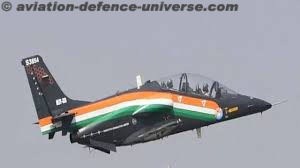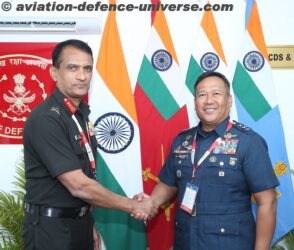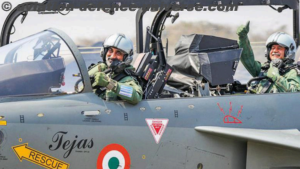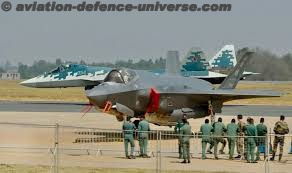It was a day full of excitement and USA gave us here in Bangalore many reasons for this frenzy. Everyone was moving towards the fighters parked on the tarmac in the static display area. For a country which saw housefull shows of the Hollywood block buster Top Gun Maverick, the presence of Tom Cruise’s fighter aircraft at Aero India 2023, was magnetic. Two F/A-18 Super Hornet Block III fighters landed at Yelahanka Airforce Station and visitors started thronging the barricade.
The two F/A-18 Super Hornets from the “Royal Maces” of Strike Fighter Squadron (VFA) 27 of US Navy are forward-deployed to Marine Corps Air Station Iwakuni, Japan and flew from there to Bangalore . The E is a single seat and the F is a two-seater and both are on static display.
The fighter is on offer to the Indian Navy for the aircraft carriers. The F/A-18E and F/A-18F are designed to meet current Navy fighter escort and interdiction mission requirements, to maintain F/A-18 fleet air defense and close air support roles, as well as an increasing range of missions, including Forward Air Controller (Airborne) and Aerial Tanking, as they have proven capability to replace the S-3 as an aerial tanker. F/A-18E/F enhancements include increased range and improved carrier suitability required for the F/A-18 to continue its key strike fighter role against the advanced threats of the 21st century.
As the U.S. Navy’s frontline fighter with over 800 aircraft delivered around the world, the Block III Super Hornet is already being deployed to the US Navy, and work is underway to upgrade over 500 Super Hornets to the latest Block III variant, which offers opportunities for cooperation in naval aviation between the United States and Indian navies, acting as a force multiplier for the Indian Navy as it interfaces with assets such as the P-8I.
The OEM Boeing reiterates that designed from its inception for carrier operations, the Super Hornet can operate from aircraft carriers , meets STOBAR performance requirements , demands minimal support equipment and also has the lowest cost per flight hour to operate while maintaining high mission readiness rates.
The two-seater variant offers availability for carrier missions, can operate on land-based missions and as trainers. It’s advanced network architecture enables P-8I interface and other U.S.-origin helicopters and future carrier-based unmanned systems.
Now lets see does it match steps with Indian government’s Make in India and Aatmanirbhar Bharat plan? They reaffirmed that Boeing sources parts, assemblies and services from Indian suppliers to support the full life-cycle of aircraft to include aerostructures, composites, machined parts and assemblies, wire harnesses, cockpit panels, aluminium raw materials, forgings, avionics, mission systems, mechanical and electrical standard parts, tooling and ground support equipment. Specifically, on F/A-18, Hindustan Aeronautics Ltd (HAL) provides the gun bay doors and Rossell Techsys provides wire harnesses. Additionally, the F/A-18 work packages are also potentially available for transfer. Boeing is reviewing over several hundred other machined assemblies that could be placed with the appropriate Indian suppliers.
And one person every Indian defence journalist enjoys to meet and interview is Salil Gupte, President, Boeing India who created the narrative earlier last year. He said and I quote “Boeing’s sourcing from India stands at $1 billion annually through its large and growing network of 280+ supplier partners – that are an integral part of our global supply base. These Indian companies are manufacturing and exporting systems and components for some of Boeing’s most advanced products from India to the world. We will continue to grow a globally competitive supplier base in India, with strong partnerships that are aligned with the government’s vision of an Aatmanirbhar Bharat. Our investments in India are creating jobs and bolstering India’s manufacturing sector. We have, through the years, invested in partnerships with players in the Indian aerospace ecosystem in diverse areas including skilling, research & technology, and manufacturing. At the Boeing India Engineering & Technology Center (BIETC), our 3,000+ diverse engineering workforce contribute to the global aerospace growth by delivering cutting-edge R&D, innovation, and high-quality engineering work to support Boeing’s defense, space, and commercial businesses.”
The OEM projects with conviction that the presence of Super Hornet as India’s carrier-based fighter will bring a positive economic impact of $3.6 billion over 10 years to the Indian economy. In addition it will also be economical to the Indian Navy by having
- Lowest acquisition and per flight costs
- High mission readiness rates
- Massive scale of the Super Hornets operating globally lowers cost of incorporating newly developed technologies
- 10,000 hours airframe designed for future upgrades
- GE F-414 engine is in the same family of engines powering India’s indigenous Light Combat Aircraft
With 11 active aircraft carriers; 800 F/A-18 Super Hornets and Growlers delivered, collaboration opportunities for carrier integration, training, and technology transfer, three out of the four countries that support a secure Indo-Pacific, operate the P-8 and two out of these four countries operate the F/A-18.
The F/A-18 Super Hornet has been designed and built for carrier operations, and is fully compliant with INS Vikramaditya and INS Vikrant aircraft carrier. F/A-18 will be able to operate on the deck, in the hangar and on the lifts of the Indian Navy’s aircraft carriers. It offer single and two-seater variants of the Super Hornet to the Indian Navy. The two-seater configuration in particular will offer several unique advantages to the Indian Navy including meeting all missions ashore and on the carrier, higher utilization of the fleet and the ability to successfully complete those missions from the carrier that benefit from having the second crew. As the Indian Navy inducts unmanned carrier borne platforms, two-seater carrier compatible aircraft will help further the interface between manned and unmanned systems in a carrier environment. In the absence of two-seater carrier compatible variant on Indian Navy carriers, approximately 15% of Indian Navy’s fleet inducted through MRCBF platform will remain ashore.
For years, Boeing teams have worked closely with the Indian Navy to analyze the overall compatibility of the F/A-18 Super Hornet Block III with Indian Navy’s current and future carriers. These complex studies involved STOBAR performance, arrested landings, aircraft spotting on the carrier deck and most importantly the fitting of the aircraft in the carrier lift and hangars. F/A-18 Super Hornet, with its wing-fold feature, offer a tried and tested, safe & practical solution for compatibility with the navy carriers.
The Super Hornet’s Precision Landing Mode software is specially designed to reduce pilot workload while landing on the Indian Navy’s Vikramaditya carrier by maintaining the proper glide slope and proper approach speeds for the aircraft during landing which increases landing performance, safety, and boarding rate. It has fully redundant systems and is independent of the carrier’s optical landing system.
In July 2022, Boeing’s F/A-18 Super Hornet successfully completed operational demonstration tests at Indian Naval Station Hansa in Goa, India, and reinforcing the Super Hornet’s ability to effectively and safety operate off Indian Navy carriers.
Two U.S. Navy F/A-18E Super Hornets completed multiple ski-jumps, roll-in and fly-in arrestments, as well as performance flights, in a variety of weights in the air-to-air, air-to-ground, and air-to-surface configurations, meeting the Indian Navy test requirements.
The tests followed eight ski-jumps in various weights and configurations during previous tests held at Naval Air Station (NAS) Patuxent River in Maryland in late 2020 that demonstrated the Super Hornet’s ability to operate from a short takeoff but arrested recovery (STOBAR) aircraft carrier, and validating earlier simulation studies by Boeing.
Boeing feels that F/A18 is just the choice Indian Navy will benefit from and US government endorses it by sending both the variants to Aero India. They are tried, tested and combat proven.
So friends ADU was privileged to see these formidable metallic birds on Yelahanka tarmac. And let me tell you they are as loveable as the hero who flew them-Tom Cruise. We will keep getting you live moments from the tarmac. So bye till we meet again.














